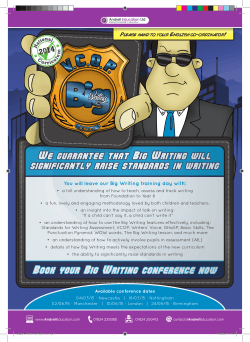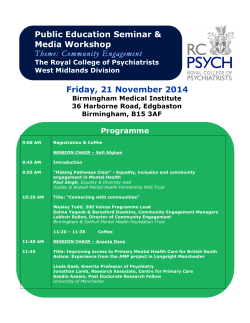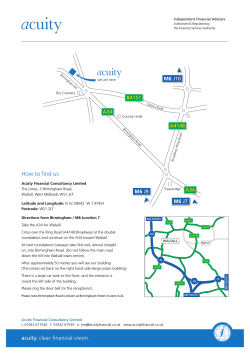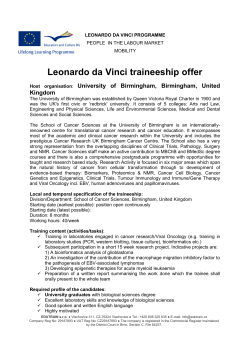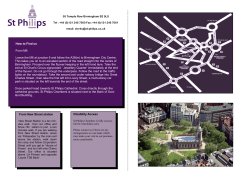
application form
SCHOOL APPLICATION FORM Each year, bursaries of up to £400 will be available to Birmingham primary, secondary and special schools for class visits to environmental outdoor centres in and around Birmingham, including a teaching session with the Centre Teacher. Priority will be given to schools that have little or no green space on the school site. The bursary will cover the cost of transport and the fee charged by the centre for entry and teaching session. If your application is successful, schools will be required to book the centre, arrange a teaching session with them, book the coach (or alternative transport), arrange appropriate insurance cover and be responsible for carrying out a risk assessment prior to the visit. Please note: self-guided visits will NOT be funded. Name of School Type of School () Birmingham City Council Academy * Other *Academy sponsor School Address Phone number Lead teacher for visit & email address Position in School Key Stage Year Group No. of Pupils for visit No. of adults Name of Centre for Visit (please tick one): Mount Pleasant School Farm Birmingham Botanical Gardens Martineau Gardens Birmingham Wildlife Conservation Park (formerly Birmingham Nature Centre) Ackers Centre (for environmental work) Amount of Bid: Transport cost Centre cost Total being applied for (maximum £400) You must organise a visit date directly with a centre if your application is successful, but an indication of preferred dates will help NAEE 1) 2) 3) Please fill in these boxes with details of your visit. This information will be used by NAEE to decide which schools will be awarded the bursaries. Continue on a separate sheet if necessary. Topic/Theme Curriculum Subject(s) Please detail the preparatory work that will be carried out in school before the visit Raising Environmental Awareness: How will the visit improve pupils’ knowledge and understanding of the environment? How will the visit help to develop caring attitudes towards the environment? How will the visit link to environmental activities carried out in your school? Please detail the follow-up work that will be carried out in school after the visit Feedback from Visit: The teacher in charge will be required to send a report of the visit to NAEE within 8 weeks of your visit, outlining how it had benefited the pupils and their learning about the environment. The report will appear as a case study either in the NAEE e-journal ‘Environmental Education’ or on its website. Photographs would be appreciated, and it is the school’s responsibility to ensure that they have been checked for permissions / data protection before the visit takes place, as NAEE may send a photographer along to the visit. Please email your application form to: info@naee.org.uk, subject: ‘Hugh Kenrick Days’ (or email NAEE for more information). Application forms will be scrutinised by a panel of executive members of NAEE. Schools will be contacted to inform them whether their bid has been successful. The visit must be carried out in the term for which the bursary was awarded. Lead teacher’s signature: ______________________________________ Date: _________________ CURRICULUM LINKS Feeling enthusiastic but unsure of the best way to make the most of this funding? The visits can be used to cover a range of curricular subjects and projects related to the environment. For example: Early Years Foundation Stage: School visits can cover the Prime and Specific Areas of Learning, particularly Understanding the World and Personal, Social & Emotional Development. Outdoor learning also covers the Characteristics of Effective Learning (Playing & Exploring, Active Learning, Creating & Thinking Critically), through sensory, seasonal and problem-solving activities. Primary science: Identifying common plants, parts of plants and flowers, growth, life cycles. Living things and their habitats. Animals – ‘minibeast’ hunts, pond dipping (emphasising care/respect for other living things), food chains Food and farming – at Mount Pleasant School Farm children can find out exactly where their food comes from, Martineau Gardens have plots where they grow organic food crops and at Birmingham Botanical Gardens, pupils can see examples of exotic plants that give us food (e.g. coffee, cocoa and bananas) Changing environments and human impacts (both positive and negative). Materials – investigating and using natural and human-made materials, links to recycling. Rocks and soils. Primary geography: Fieldwork and observational skills. Exploring the local environment. Comparing contrasting environments with the school grounds. Finding out about plants and animals from other parts of the world (e.g. rainforest animals at Birmingham Wildlife Conservation Park). Primary design and technology: Growing food crops and using in healthy recipes. Links to plant life cycles and plant parts/functions in science (e.g. the use of leaves, roots/tubers/bulbs, seeds and fruit as food). Secondary science: Fieldwork techniques, such as freshwater sampling methods and quadrat/transect sampling. Structure and function of living organisms – plants (including photosynthesis, pollination, life cycles) and animals (e.g. invertebrate sampling). Evolution and adaptation. Studying different ecosystems (such as temperate woodland at Ackers Adventure, rainforests at the Botanical Gardens). Secondary geography: Using fieldwork in contrasting locations, including map skills. Human and physical geography related to a range of landscapes and environments. Understanding human impacts (positive and negative) on local and global environments. Other: Environmental art and craft activities. Environmental and Land Based Science GCSE. ‘Forest School’ activities with a focus on the environment. Sustainability issues, e.g. growing food locally, developing sustainable communities. Local history activities.
© Copyright 2025

